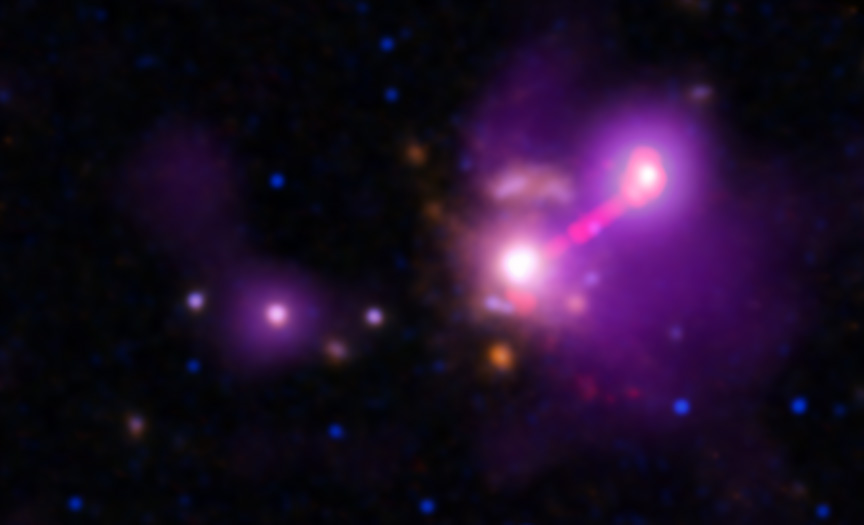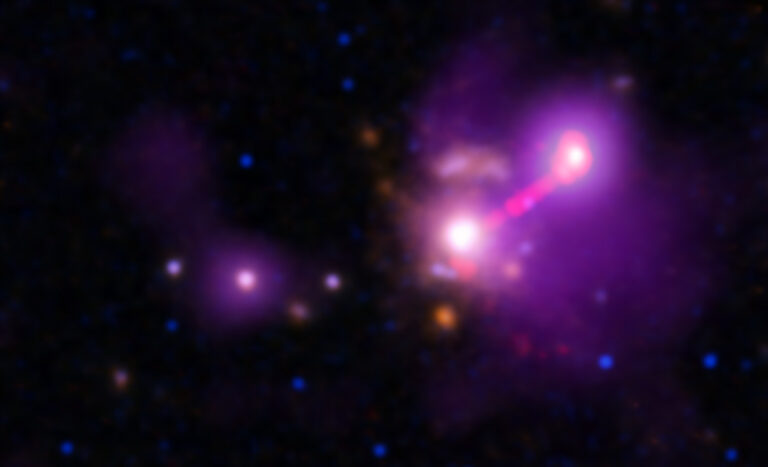A large galaxy spewing a black hole.
A large galaxy spewing a black hole–powered jet might have eaten its neighbors, leaving it on its own.
At a time when most galaxy clusters were still in the process of formation, one cluster was already in its end game, consisting of only one galaxy that had devoured all of its companions, according to recent observations. This unique galaxy, known as a fossil group, is 3C 297, which is a giant elliptical galaxy located 9.2 billion light-years away from Earth and has a supermassive black hole at its center with a black hole-powered jet that extends 140,000 light-years into space.

X-ray: NASA / CXC / Univ. of Torino / V. Missaglia et al.; Optical: NASA / ESA / STScI & International Gemini Observatory / NOIRLab / NSF / AURA; Infrared: NASA / ESA / STScI; Radio: NRAO / AUI / NSF
Although this kind of galaxy is typically associated with groups with many members, Chandra X-ray Observatory images reveal that there is a million-degree gas surrounding 3C 297, indicating the presence of a giant gas halo, but only one galaxy. Astronomers expected to find many galaxies similar to the Milky Way, but spectroscopic measurements with the Gemini Observatory in Hawaii showed that there were no galaxies that were close to 3C 297, indicating that any missed companions would have to be 10 times fainter, similar in size to dwarf galaxies.

X-ray: NASA / CXC / Univ. of Torino / V. Missaglia et al.; Optical: NASA / ESA / STScI & International Gemini Observatory / NOIRLab / NSF / AURA; Infrared: NASA / ESA / STScI; Radio: NRAO / AUI / NSF
According to recent observations, a giant elliptical galaxy named 3C 297 may be a fossil group, which is unusual since it’s made up of only one galaxy. Most galaxy clusters were still forming during the time when the universe was one-third of its current age, but 3C 297 was already in the end game, having consumed all of its companions. The galaxy hosts a supermassive black hole and a powerful jet extending some 140,000 light-years into intergalactic space. New observations of its environs using the Chandra X-ray Observatory reveal a million-degree gas halo surrounding the galaxy, typical of groups with many members.
However, spectroscopic measurements with the Gemini Observatory in Hawai‘i suggest that there are no other galaxies near 3C 297, and any undetected companions would have to be dwarf galaxies. This finding could push the limits on how quickly galaxies and galaxy clusters must have formed.
While this fossil group may be a record-breaker, residing in a universe just 4.5 billion years old, it’s possible that it’s in an earlier stage of evolution, having recently undergone a merger.
Do not forget to share your opinion with us to provide you with the best posts !




0 Comments